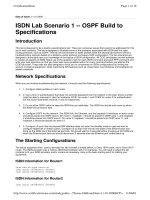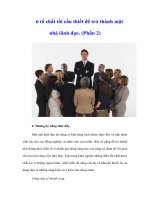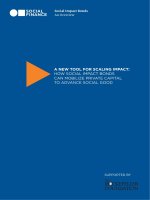Build to lead how to lego bricks can make
Bạn đang xem bản rút gọn của tài liệu. Xem và tải ngay bản đầy đủ của tài liệu tại đây (6.78 MB, 58 trang )
Business
Build to Lead
How Lego Bricks Can Make You a Better Leader
Donna Denio and Dieter Reuther
Build to Lead
by Donna Denio and Dieter Reuther
Copyright © 2016 O’Reilly Media, Inc. All rights reserved.
Printed in the United States of America.
Published by O’Reilly Media, Inc., 1005 Gravenstein Highway North,
Sebastopol, CA 95472.
O’Reilly books may be purchased for educational, business, or sales
promotional use. Online editions are also available for most titles
(). For more information, contact our
corporate/institutional sales department: 800-998-9938 or
Editor: Laurel Ruma
Production Editor: Shiny Kalapurakkel
Copyeditor: Dan Fauxsmith
Interior Designer: David Futato
Cover Designer: Karen Montgomery
Illustrator: Rebecca Demarest
March 2016: First Edition
Revision History for the First Edition
2016-03-21: First Release
The O’Reilly logo is a registered trademark of O’Reilly Media, Inc. Build to
Lead, the cover image, and related trade dress are trademarks of O’Reilly
Media, Inc.
While the publisher and the authors have used good faith efforts to ensure
that the information and instructions contained in this work are accurate, the
publisher and the authors disclaim all responsibility for errors or omissions,
including without limitation responsibility for damages resulting from the use
of or reliance on this work. Use of the information and instructions contained
in this work is at your own risk. If any code samples or other technology this
work contains or describes is subject to open source licenses or the
intellectual property rights of others, it is your responsibility to ensure that
your use thereof complies with such licenses and/or rights.
978-1-491-95948-0
[LSI]
Build to Lead: How Lego Bricks
Can Make You a Better Leader
Harnessing the Power of Play at Work
What if you could harness the power of play — something we all knew but
most of us forgot — to empower your teams, and at the same time help you
realize creative and powerful solutions in the face of today’s business
challenges? There is a tried-and-true process — Lego Serious Play — that is
guaranteed to expand your leadership capacity and deliver predictable and
consistently productive results. You will learn how and why this tool boosts
both individual and team productivity. It sounds almost too good to be true,
but, yes, playing with Lego bricks can help make you and your team more
productive (see Figure 1-1). And who doesn’t love an excuse to play with
Lego bricks?
Figure 1-1. Businesses face a number of challenges
Lego Serious Play is a facilitated team-thinking and problem-solving process
in which you build Lego models in response to challenge questions, such as
“Build a barrier to teamwork.” The process has a variety of applications that
can be used for problem solving, strategy development, feedback, ideation,
product development, relationship building, goal setting, debriefing, and
performance reviews. And the 3D representations create an easy to
understand, level playing field where everybody has a voice and everybody
can express his or her thoughts. It’s an incredibly effective way to get
everyone’s ideas on the table and, together, develop a collective plan of
action (see Figure 1-2).
Figure 1-2. An example of individual model building
In his book The Play Ethic, Pat Kane says “Play will be to the 21st century
what work was to the industrial age — our dominant way of knowing, doing
and creating value.” Yeah, just try to tell that to my boss, you think. Now,
wait a minute. We all know that children learn and explore personal
limitations and boundaries through play, and we also know — through
breakthroughs in neuroscience — that we continue to learn and grow
throughout our lives. Yet teachers, parents, and cultural expectations have
conditioned us from a very early age to believe that work and play are
opposites. Like oil and water, the two do not easily mix (see Figure 1-3).
Figure 1-3. The rise of play
Play is what we do as children or outside of work. It brings us pleasure. (And
we all know work is work, it’s not supposed to bring us pleasure or be fun
☺.) As kids, play helps us prepare for life. It provides us with a safe
environment where we can fail with few consequences and practice important
skills that we’ll need later in life. Research shows that kids who miss out on
playing with others (where they practice their social skills), will have a harder
time interacting with others later on in life.
As life-long learners, play can continue to work its magic throughout all
stages of our life. After all, creativity thrives in safe environments, and we all
benefit from building more trusting relationships with our clients and
coworkers. And we’re sure you can think of at least a couple coworkers who
could benefit from improved social skills.
Play can transform us into a state where we are completely absorbed by our
activity to the point where nothing else in the world seems to matter. This
playful state provides a feeling of energized focus, full involvement, and
enjoyment in the process of the activity. This focus is uniquely suited to highlevel reasoning, insightful problem solving, and all sorts of creative
endeavors. Mihaly Csikszentmihalyi calls this powerful state of mind “beingin-flow” — also called “the zone” — with just the right balance of challenge
and opportunity, given our skill sets. We know from experience that Lego
Serious Play can activate these “being in flow” moments at work (see
Figure 1-4).
Figure 1-4. The flow principle
We’ve all experienced times when this effortless alignment exists. Remember
that successful project where interactions with others were light and playful?
Where the team laughed and joked a lot? Why are these moments so rare? As
we mature, we minimize the playful mindset for the more serious adult nature
that is the cultural norm. We are conditioned to believe that hard work, not
play, is the secret to success. Everyone wants to be successful, taken
seriously (be serious), and also have others respect us and our opinions. We
live in a world divided — the world of work and the world of everything
outside of work. In the work world, we are serious, work long hours, and
make many compromises for the sake of earning a good salary, climbing the
corporate ladder, and providing for our families. In the fun, playful part of
our lives outside of work, we go on vacations, spend time with our friends
and family, and invest energy in our hobbies.
Bringing back that childhood enthusiasm for play into work life will unlock
innovation and creativity. Through Lego Serious Play we can learn to push
the boundaries of conventional ideas — it helps us to think outside the box
and challenge the status quo.
Tim Brown, CEO and president of the global design company IDEO, likes to
use this exercise on creativity and play: he asks everyone in the audience to
draw a quick sketch of the person sitting next to them (in just 30 seconds).
When everyone is done sketching, the audience is typically very hesitant to
show off their work. Brown explains that contrary to adults, kids would not
be embarrassed at all. They would be happy to share their sketches. What
happens is that as we grow up, we unlearn our creativity by becoming
sensitive to the opinions of others. In exchange for serious responsibilities,
we leave the crazy thoughts, ideas, and brilliant questions from our childhood
behind.
While teaching, Gordon MacKenzie realized that when he asked kids the
question, “are you an artist,” every child in first grade raised their hand, in
second grade about 50% did, and in third grade only about 30% raised their
hand (see Figure 1-5). He sadly had to admit that every school he visited was
participating in the suppression of creative genius (Orbiting the Giant
Hairball: A Corporate Fool’s Guide to Surviving with Grace).
Figure 1-5. Kids feel less creative as they grow up
One of the major advantages of Lego Serious Play in comparison to other
creativity exercises and tools — such as sketching, forming pipe-cleaner
figures, or role play — is that building with bricks is less intimidating. Many
people have reservations about their artistic or thespian talents. Everyone can
stick two or three bricks together. And you can tell a story with a single brick,
especially single “bricks” in evocative shapes such as doorways, lions, or
translucent blue globes.
Play can reestablish a safe environment and foster the creative-thinking
capacity that we’ve lost along the way. It creates the time, space, and
structure to give people a voice and the permission to share those wild ideas,
thoughts, and questions, just like we did as kids. It lets us imagine and create
a possible or probable future and test the advantages and limitations of this
new world. This creative aspect of play is fundamental to cocreating future
conditions that are more desirable than the present status quo.
Lego Serious Play was conceived with all the advantages of play and all of
the self-imposed limitations and reservations of adults in mind. The colorful
aspect of the bricks sets the tone. Then the facilitator carefully guides the
team through a new process that becomes more and more comfortable and
predictable as the building challenges unfold. First, the challenge, then
mindlessly (or mindfully) building something (as the model emerges, even
the model-builder is often surprised), listening to each other’s stories, telling
your own, and then discussing lessons learned. When a team is engaged in
building, the room feels energetic, people are laughing, telling each other
stories, and learning from each other.
How Lego Bricks Apply to the Future of Work
Have you recently visited one of the coworking spaces that are popping up all
over our cities? A buzzing of young knowledge workers, shared common
areas, and foosball tables are surrounded by workers taking a break. Some
workers even turn into nomads and spend most of their time in coffee shops.
Most large companies have areas designated for “hoteling,” where
salespeople, who are often on the road visiting out-of-town workers or
clients, can be assigned to temporary workspaces. The business world is
changing at a rapid pace, and there has been a lot of discussion about what
the future of work might look like.
Changing Societal Structures
The approach of using hard work to achieve success worked well for the past
100 years, when bureaucratic hierarchies dominated corporate structures of
the Industrial Age. The pyramid-shaped structure of the Industrial Age still
persists in many of today’s organizations and is profiled in management
textbooks. The pyramid shape of the hierarchy is so prevalent that org chart
templates are shaped this way. According to Peter Thomson, the
acknowledged authority on the changing world of work, “Organizations are
still run as hierarchical command systems in a world of networked
individuals and self-employed entrepreneurs.” Today, material abundance,
technological advancements, and globalization impact how we live, work,
and see the world. We are now in the midst of moving away from the
Information Age, which is characterized by serial, logical, rule bound, and
computer-like processing, to the new Conceptual Age, where parallel
processing, aesthetics, emotions, and contextual thinking dominate.
Contemporary workers and business goals make the past status-and-powerbased structures inconsistent with work practices that engage the hearts and
minds of younger workers and, more importantly, the nature of the work
itself.
Structures that define culture fall into three categories: processes, tools, and
environments. As we begin to think creatively about redefining workplace
culture, we can look at all three — work processes, work tools, and work
environments — and ask ourselves, does this process, tool, or environment
give a power advantage to some or does it equalize power and encourage
equal participation?
Evolving Office Spaces
The shift from assembly line to integrated work group is more obvious in the
layouts of physical space than formal or informal organizational structures.
Physical space layout is visible; organizational structures and networks are
invisible until you’re there a while. We all know that the org charts drawn on
paper often have little in common with the way things actually work (see
Figure 1-6).
Figure 1-6. Examining organizational structure
The rows of office cubicles, made infamous in Dilbert cartoons, are gradually
being replaced by open workspaces where needs for privacy are
accommodated by strategically placing small conference rooms and phone
rooms throughout the space. The similarities between rows of cubicles and
assembly lines are pretty obvious.
If we’re expected to interact with others throughout the workday, and
answers to questions, challenges, and productivity live within the team (and
not in the individual), what space layout makes sense? What organizational
shape makes sense? And what workplace tools make sense? Organizations
are seriously rethinking how and why they work and are bringing new ideas
and innovation to all these areas. Specific changes related to working
collaboratively and increasing flexibility in the workplace are seen across
most industries, not just Silicon Valley. Fast Company reports the top 10
office design trends in 2016 include 20-foot community tables and the end of
permanent furniture layouts.
Another example can be seen in Google’s mission statement:
“When you want people to think creatively and push the boundaries of
what’s possible, their workspace shouldn’t be a drab maze of beige
cubicles. Our offices have become well known for their innovative, fun
and — some might say wacky — design. Like most of our decisions, data
shows that these spaces have a positive impact on productivity,
collaboration, and inspiration. Simply put, we aim to make our offices a
place that Googlers want to be.”
Additional detailed description of Google’s NYC headquarters comes from a
New York Times article,1 “Next to the recently expanded Lego play station,
employees can scurry up a ladder that connects the fourth and fifth floors,
where a fiendishly challenging scavenger hunt was in progress. Dogs strolled
the corridors alongside their masters, and a cocker spaniel was napping,
leashed to a pet rail, outside one of the dining areas.”
Does this sound like the type of place you’d like to work? It certainly is
radically different from the fabric-covered cube farms that are seen in most
offices.
Challenge of Having Four or Five Generations in the
Same Workplace
The Gen Y workers who are building their careers have different priorities
and values than the previous generation. They are ready to work hard, but
also want to have fun and find meaning in their work. According to Stewart
D. Friedman, a professor at the University of Pennsylvania, “Young people
today want to have a positive social impact through their work. If their jobs
resulted in greater social impact and made more use of their talents, they
might not feel the need to split time between work and civic engagement.”2
They also want to express themselves, wear comfortable clothes, and
eliminate mind-numbing routine chores.
Most of today’s emerging leaders don’t know a world without the Internet. In
the words of Peter Thomson, “They expect to be able to communicate with
their colleagues wherever they are and whenever they choose. They cannot
understand the traditional boundaries between home and work life and the
need to be tied to a fixed desk in order to get work done. They are
questioning the long hours culture and the “presenteeism” pattern of work
that has been inherited from previous generations. And they value their
personal freedom, expecting to be given some discretion over the place of
work in their lives.”3
Collaboration in Today’s Business Environment Is Key,
Even for Introverts
Our mental model of work hasn’t kept up with today’s reality. The idea of
work being hard and labor intensive is a mental model created in the days
when farm and factory work prevailed. As jobs requiring manual labor were
replaced by those that didn’t involve getting your hands dirty, management
guru Peter Drucker coined the term “knowledge work.” Knowledge workers
can only master the complexity of today’s business environment through
collaboration — a collaboration of many different specialists — to harness
their collective intelligence, based on difference, not sameness. Individual
differences serve collaboration. Such a sharing culture requires an equal
playing field on which differences are valued rather than rejected.
It is almost instinctive to like and trust the people most like you. Management
textbooks in the 1980s actually described corporate culture as an extension of
the values of the organization’s founders, and often the founders were people
who had worked or socialized together; for example, members of the same
family, classmates from the same college, or people who served together in
the military. The idea of people with different backgrounds actually
understanding each other and, more importantly, respecting each other’s
thoughts and opinions, and then trusting each other is an admirable idea, but
only an idea. Without some type of special training or intervention, people
from different backgrounds (whether cultural or professional) are likely to
discount each other’s wisdom, unjustly categorize each other because of age
or background (e.g., he’s out of touch, he’s a brainiac, she’s just a wiseacre
kid, accountants only care about the bottom line, marketing people give the
store away, and so on), or just not seek each other out.
Bringing people together in a way that allows them to contribute equally is
one of the core concepts in the design of Lego Serious Play. The process
ensures that everyone participates in an equal way and also provides the time
and space to really listen to each other. The person leading the workshop
designs and presents a customized series of challenges based on the
workshop goals. Each team member constructs an individual 3D model in
response to the challenge posed, and in turn, shares a story about this model.
After several rounds of individual model building, team members are given
challenges that require them to combine key elements of their individual
models into a single model or a larger system and scenario model that allows
them to visualize, explore, and understand system behaviors.
Once a workshop begins, the facilitator is responsible for adhering to the
process etiquette, which mandates that everyone build his or her own model
and everyone tell a story about his or her own model. No one is allowed to
skip or pass on any part of the process. Because you know you will have a
turn to speak, you can really listen to what others are saying instead of
listening for a break in the rapid flow of conversation so you can interject
your idea.
Thoughtful, introverted people (often visual thinkers, engineers, or
accountants) have the same opportunities and access as extroverted, verbally
fluent people. People who are shy and like to think things through before
speaking have time to think while they build and find it easier to express
themselves when they refer to the visual prop their model provides. Post
workshop, one engineer was close to tears. He said, “Thank you for helping
me communicate.” The IT manager in a leadership workshop for a nonprofit
had a similar reaction.
Lego Serious Play transforms the dream of collaboration into the reality of
people who are very different by helping them to express their best thoughts
in a safe, supportive environment. When Donna, one of the authors of this
report, trained with a group of facilitators from around the world — one from
Japan, two from Singapore, and a Canadian — she found that the dynamic
among and between people she just met was closer (and they knew more
about each other) than with people she had worked with for many years.
In this open, safe, trusting, and collaborative environment created by Lego
Serious Play, today’s organizations can achieve enhanced productivity,
agility, and keep people motivated at the same time. This is the context that
supports and enhances the magic of creativity and innovation.
Getting Past the Meeting Conundrum
The new collaborative approach requires that knowledge workers work
closely with others and spend much of their workday in meetings. However,
traditional meetings are often not effective and have long been the source of
frustration for almost everyone in the workforce. There are many studies of
how many hours each of us spend in meetings each day, month, and year and
how many hours are wasted in them. One example is a study conducted in
2005 by Microsoft involving 38,000 participants in 200 countries. Employees
spent an average of 5.6 hours in meetings each week, and 69% of them say
these meetings were unproductive.4
Almost all aspects of the work we do have evolved in recent years: our
workplaces have transformed from manufacturing and industrial work to
knowledge and creative work; from office cubes to open space plans; from
homogeneous groups of workers to work communities rich in diversity of
age, gender, ethnicity, and educational background. Yet, for the most part, the
structure of meetings has stayed the same and only the technology has
changed: in addition to face-to-face meetings in offices and conference
rooms, we now have phone meetings and video conferences with remote
workers and external partners.









